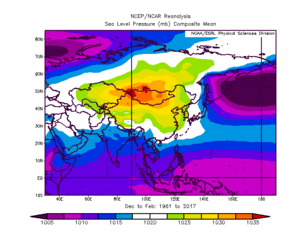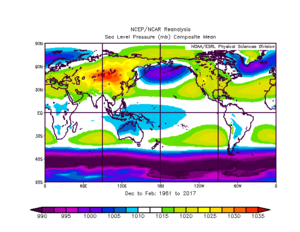المرتفع السيبىري
| المرتفع السيبيري Siberian High | |
|---|---|
 | |
| Area of occurrence | الجزء الشمالي الشرقي من أوراسيا |
| Season | سبتمبر–أبريل |
| Effect | برودة شتاء قارص تصحبها حالات جافة بقليل من الثلج وقلة من المَثلجات |
المرتفع السيبيري ( Siberian High ؛ also Siberian Anticyclone; روسية: Азиатский антициклон (Aziatsky antitsiklon); الصينية: 西伯利亞高壓; Pinyin Xībólìyǎ gāoyā) is a massive collection of cold dry air that accumulates in the northeastern part of Eurasia from September until April. It is usually centered on Lake Baikal.[1] It reaches its greatest size and strength in the winter when the air temperature near the center of the high-pressure area is often lower than −40 °C (−40 °F). The atmospheric pressure is often above 1،040 مليبار (31 inHg). The Siberian High is the strongest semi-permanent high in the northern hemisphere and is responsible for both the lowest temperature in the Northern Hemisphere outside Greenland, of −67.8 °C (−90.0 °F) on 15 January 1885 at ڤرخويانسك، and the highest pressure, 1083.8 mbar (108.38 kPa, 32.01 inHg) في أگاتا، كراي كراسنويارسك، on 31 December 1968, ever recorded.[2] المرتفع السيبيري مسئول عن كلٍ من برد شتوي قارص مصحوب بظروف جافة مع قليل من الثلج وقلة من المَثلجات في أرجاء الجزء الآسيوي من روسيا ومنغوليا و الصين. During the summer, the Siberian High is largely replaced by the Asiatic low.
المرتفع السيبيري (أو الآسيوي) هو مركز ضغط جوي مرتفع شبه دائم يتمركز نحو القطب الشمالي فوق خط العرض 45° ش على شمال شرق سيبيريا.[3][4] وهو من أشهر التوزيعات الضغطية التي تؤثر على مصر خلال فصل الشتاء، وهو عبارة عن كتلة ضخمة من الهواء البارد تتجمع فوق منطقة سيبيريا الواقعة شمال شرق أوراسيا، تتشكل نتيجة التبريد السطحي الشديد فوق المناطق القارية البعيدة عن التأثيرات البحرية.
استعراض

The Siberian High affects the weather patterns in most parts of the Northern Hemisphere: its influence extends as far west as Italy,[5] bringing freezing conditions also in the warm South,[6] and as far southeast as Malaysia,[7] where it is a critical component of the northeast monsoon. Occasionally a strong Siberian High can bring unusually cold weather into the tropics as far southeast as the Philippines.[8] It may block or reduce the size of low-pressure cells and generate dry weather across much of the Asian landscape with the exception of regions such as Hokuriku and the Caspian Sea coast of Iran that receive orographic rainfall from the winds it generates. As a result of the Siberian High, coastal winters in the main city of Pacific Russia Vladivostok are very cold in relation to its latitude and proximity to the ocean.
Siberian air is generally colder than Arctic air, because unlike Arctic air which forms over the sea ice around the North Pole, Siberian air forms over the cold tundra of Siberia, which does not radiate heat the same way the ice of the Arctic does.[9]
التكوين والتفاوت
In general, the Siberian High-pressure system begins to build up at the end of August, reaches its peak in the winter, and remains strong until the end of April. Its genesis at the end of the Arctic summer is caused by the convergence of summer air flows being cooled over interior northeast Asia as days shorten. In the process of the Siberian High's formation, the upper-level jet is transferred across northern Eurasia by adiabatic cooling and descending advection, which in extreme cases creates "cold domes" that outbreak over warmer parts of East Asia.
In spite of its immense influence on the weather experienced by a large proportion of the world's population, scientific studies of the Siberian High have been late in coming, though variability of its behavior was observed as early as the 1960s.[1] However, recent studies of observed global warming over Asia have shown that weakening of the Siberian High is a prime driver of warmer winters in almost all of inland extra-tropical Asia and even over most parts of Europe,[1] with the strongest relationship over the West Siberian Plain and significant relationships as far west as Hungary and as far southeast as Guangdong. Precipitation has also been found to be similarly inversely related to the mean central pressure of the Siberian High over almost all of Eastern Europe during the boreal winter, and similar relationships are found in southern China, whilst the opposite correlation exists over the Coromandel Coast and Sri Lanka. Other studies have suggested that the strength of the Siberian High shows an inverse correlation with the high-pressure systems over North Africa. Another correlation has been noted, a connection of a weaker Siberian High and Arctic oscillation when the Antarctic oscillation (AAO) is stronger.[10]
Because increased snow and ice cover enhances the Siberian High,[11] the Siberian High was both more intense and located further west during the early Middle Pleistocene as a result of the extensive glaciation of mountain ranges across Central Asia.[12] The decrease in magnitude of the Siberian High during the Holocene enabled eastward encroachment of westerlies enriched with water vapour, precipitating an increase in low altitude afforestation of Central Asia.[13]
مصر والمرتفع السيبيري
قال خبراء الأرصاد الجوية مؤخراً، إن مصر ستتأثر بـ مرتفع سيبيري سيؤثر بدوره على حالة الطقس في مصر عند وصوله،[14] وليس مصر وحدها من سيتأثر خلال فصل الشتاء بالمرتفع بل ستشمل التأثيرات بعض الدول الأخرى في أوروبا وجنوب وغرب آسيا وهضبة أرمينيا والأناضول وشمال العراق. ويعتبر المرتفع السيبيري هو المسئول عن موجات البرد القارس والجاف في مناطق واسعة من أوروبا وآسيا، ولكن في أفريقيا الأمر يختلف، فعند مروره إلى شمال إفريقيا وعبور البحر المتوسط يحدث تعديل للكتلة شديدة البرودة ويحدث تغيير فى درجات الحرارة وتتحول من باردة جدا إلى معتدلة.
موعد المرتفع السيبيري في مصر
ينشط غالبًا في كل عام في شهر 12 ويبدأ يؤثر بشكل قوي على باقي فصل الشتاء،[15] مما يؤثر على انخفاض في درجات الحرارة، قد تصل درجات الحرارة خلال فترات النهار إلى 15 درجة، وفي حالة الصقيع قد تصل درجات الحرارة إلى 2 و3 درجة مئوية. في 27 ديسمبر 2022 أوضحت منار غانم، عضو المركز الإعلامي لـ هيئة الأرصاد الجوية ، أن المرتفع السيبيري من المرتفعات الجوية المؤثرة بشدة على حالة الطقس، والمرتفع السيبيري يأتي من مناطق تصل فيها درجات الحرارة إلى -40 و-50، مناطق شديدة البرودة، ليأتي من سيبيريا، لذا أطلق عليه المرتفع السيبيري.
وأكدت غانم خلال مداخلة هاتفية لها في برنامج «صباح الورد» على أن المرتفع السيبيري سيؤثر على أغلب محافظات الجمهورية، وتأتي الكتل الهوائية المثرة على انخفاض درجات الحرارة في مصر من دول شرق آسيا، لتمر على البحر المتوسط لتؤثر على محافظات الجمهورية، وانخفاض درجات الحرارة خاصة المحافظات الشمالية ومن ثم الساحلية والقاهره الكبرى، وسيظهر تأثير المرتفع السيبيري في شهر يناير، وفبراير ومارس.
وسجل الطقس في القاهره درجات حرارة منخفضة خلال فترات الليل لتصل إلى 11 و12 درجة مئوية، وانخفاض شديد في سناء ومرتفعات سانت كاترين لتصل فيها إلى 2 و3 درجة مئوية، وفي يناير قد تصل إلى تحت الصفر.
انظر أيضاً
المراجع
- ^ أ ب ت “The Siberian High and Climate Change over Middle to High-Latitude Asia” Archived 26 أبريل 2012 at the Wayback Machine
- ^ Encyclopedia of world climatology by John E. Oliver, 2005, ISBN 1-402-03264-1
- ^ “The Siberian High and Climate Change over Middle to High-Latitude Asia” {{|date= مايو 2019 |bot=JarBot}} Archived 2013-11-20 at the Wayback Machine
- ^ "Antarctic oscillation and the dust weather frequency in North China". Geophysical Research Letters.
{{cite web}}: Missing or empty|url=(help) - ^ D'Arrigo, Rosanne; Jacoby, Gordon; Wilson, Rob; Panagiotopoulos, Fotis (2005). "A reconstructed Siberian High index since A.D. 1599 from Eurasian and North American tree rings" (PDF). Geophysical Research Letters. 32 (5). Bibcode:2005GeoRL..32.5705D. doi:10.1029/2004GL022271.
- ^ "Icy wind from Siberia will bring winter back to Italy - The Local". Archived from the original on 2018-02-21.
- ^ Chang Chih-peh, The East Asian Monsoon; p. 55. ISBN 978-9-812-38769-1
- ^ "Record Chill Spreads Deep into Southeast Asia"
- ^ "Siberian anticyclone | meteorology".
- ^ Fan, Ke (2004). "Antarctic oscillation and the dust weather frequency in North China" (PDF). Geophysical Research Letters. 31 (10): n/a. Bibcode:2004GeoRL..3110201F. doi:10.1029/2004GL019465. hdl:10289/1741.
- ^ Cohen, Judah; Saito, Kazuyuki; Entekhabi, Dara (January 2001). "The role of Siberian High in Northern Hemisphere climate variability". Geophysical Research Letters. 28 (2): 299–302. Bibcode:2001GeoRL..28..299C. doi:10.1029/2000GL011927. hdl:1721.1/110326. S2CID 129024923. Retrieved 4 November 2022.
- ^ Bradák, B.; Újvári, G.; Stevens, T.; Bógalo, M. F.; González, M. I.; Hyodo, M.; Gomez, C. (1 January 2022). "Potential drivers of disparity in early Middle Pleistocene interglacial climate response over Eurasia". Palaeogeography, Palaeoclimatology, Palaeoecology. 585: 110719. Bibcode:2022PPP...58510719B. doi:10.1016/j.palaeo.2021.110719. S2CID 239066555.
- ^ Zhang, Dongliang; Chen, Xi; Li, Yaoming; Zhang, Shengrui (15 July 2020). "Holocene vegetation dynamics and associated climate changes in the Altai Mountains of the Arid Central Asia". Palaeogeography, Palaeoclimatology, Palaeoecology. 550: 109744. Bibcode:2020PPP...55009744Z. doi:10.1016/j.palaeo.2020.109744. S2CID 216474621. Retrieved 5 November 2022.
- ^ "المرتفع السيبيري ينشف العظام.. تتأثر به مصر ودرجات الحرارة تصبح - 50". 2022-12-28.
- ^ "الأرصاد توضح مفاجآت جديدة عن المرتفع السيبيري الذي تتعرض له مصر". 2022-12-28.
- CS1 errors: requires URL
- Pages using gadget WikiMiniAtlas
- Short description matches Wikidata
- Articles containing روسية-language text
- Pages using Lang-xx templates
- Articles containing Chinese-language text
- جميع الصفحات التي تحتاج تنظيف
- مقالات بالمعرفة تحتاج توضيح from February 2024
- Pages with empty portal template
- Coordinates on Wikidata
- Anticyclones
- مناخ آسيا
- مناخ أوروپا
- مناخ روسيا
- Climate change in Russia
- مناخ الصين
- بيئة منغوليا